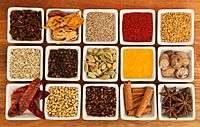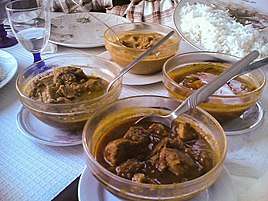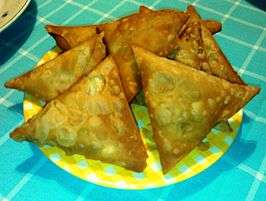Goan cuisine
Goan cuisine consists of regional foods popular in Goa, an Indian state located along India's west coast on the shore of the Arabian Sea. Rice, seafood, coconut, vegetables, meat, pork and local spices are some of the main ingredients in Goan cuisine. The area is located in a tropical climate, which means that spices and flavors are intense. Use of kokum is another distinct feature. Goan food is considered incomplete without fish.
 |
| This article is part of the series on |
| Indian cuisine |
|---|
|
Regional cuisines
|
|
Ingredients, types of food
|
|
See also
|
|
Related cuisines |
|
The cuisine of Goa originated from its Hindu Saraswat cuisine roots, and was influenced by the 451 years of Portuguese colonisation and the century of Muslim rule that preceded the Portuguese.[1] Many Catholic dishes are either similar to or variants of their Portuguese counterparts in both naming or their use of ingredients.
Seafood

The cuisine is mostly seafood-based; the staple foods are rice and fish. Kingfish (vison or visvan) is the one of most commonly eaten. Other commonly eaten seafood includes pomfret, shark, tuna, sardines, and mackerel amongst other river fishes. Among the shellfish are crabs, prawns, tiger prawns, lobster, squid, and mussels. The food of Goan Christians is heavily influenced by the Portuguese (the use of vinegar, for example, is very prominent).
Introduction of new foods
The Portuguese introduced potatoes, tomatoes, pineapples, guavas, and cashews from Brazil to Goa and consequently India. The chili pepper is the most important aspect of Goan cuisine; it was introduced by the Portuguese and became immensely popular as a very important spice for wider Indian cuisine. The Portuguese also introduced beef and pork, meats that were and still are considered a taboo by Hindus of Goa, to converts to Catholicism.[2]
Goan Hindu cuisine
Goan Hindu cuisine in Goa is mainly pescetarian and lacto-vegetarian and is very similar to Saraswat cuisine, from which it originates. Goan Hindu cuisine is mild, with use of tamarind and kokum for souring, and jaggery for sweetening. It uses spices such as asafoetida, fenugreek, curry leaves, mustard, and urad dal. Onion and garlic are also used. It also includes vegetables, such as lentils, pumpkins, gourds, bamboo shoots, and roots.The medium of cooking is coconut oil.
Popular Goan Hindu dishes include:
- Humann (हूमण) – Fish curry and rice (शीत or भात), also known as kadi or ambot
- Fried fish (तळील्ले नूस्ते)
- Fish suke or dhabdhabit (सुकें) – Dry spicy preparation of fish, eaten as a side dish
- Fish udid methi or uddamethi (उद्दमेथी) – Type of curry consisting of fenugreek and mackerel; a vegetarian version of this dish is also prepared using hog plums (or anything sour and tangy, such as pieces of raw mango)
- Kismur (किस्मुर) – A type of side dish normally consisting of dried fish (mostly mackerel or shrimp), onions, and coconut
- Dangar – Goan fish cutlets (डांगर)
- Kalputi – A dish normally prepared from the head of a large fish, with onions and coconut
- Bhaaji or shak – A generic term for stews, curries, and stir-fried dishes made from different vegetables and fruits (भाजी or शाक)
- Bhaji - Fried fritters with besan batter. Different kind of bhajis can be made by changing the vegetable used with besan. Popular bhajis include those containing onion or chilies.
- Khatkhate (ख़तखतें)
- Varan - A lentil preparation often made with coconut milk tempered with mustard, curry leaves, and chilies, served as an accompaniment to rice for the Naivedya, prepared during all Hindu festivals, and an integral part of wedding feasts.
- Tondak – A dish with beans and cashews as the primary ingredients (तोंडाक)
- Different varieties of sweets made from rice and lentils, such as payasu, patoli, madgane and kheer. (गोड्शें)
- Different varieties of pickles and papads (लोणचे or पापड)
- Solachi kadi – A spicy coconut and kokum curry (कडी)
Goan Catholic cuisine

Goan Catholic cuisine in Goa is a fusion of Goan Hindu and Portuguese cooking styles. Vinegar (made from the toddy of local coconut trees) is used to give the zingy taste to the meat dishes.
Popular Goan Catholic dishes include:
- Ambot tik – A spicy and sour curry prepared with fish
- Arroz doce – A Portuguese derivative of kheer (sweetened rice custard)
- Balchão – A curry made with prawns/shrimp
- Bebinca – A multi-layered baked pudding traditionally eaten at Christmas
- Cafreal – A masala marinate mostly used for chicken or fish made from coriander leaves, green chilies, and other spices.
- Canja de galinha – A type of chicken broth served with rice and chicken.
- Chamuça – A Goan/Portuguese derivative of the samosa
- Chouriço – A spicy pork sausage
- Croquettes – Fried minced beef rolls, a common snack among Goan Catholics and the Portuguese
- Feijoada – A stew brought by the Portuguese. It is made with meat (beef or pork), beans, and cabbage.
- Patoleo or patoli – A dish of turmeric leaves stuffed with rice, dal, jaggery, and coconut
- Roast beef and beef tongue – Popular entrees at Goan celebrations
- Ros omelette – An omelette drowned in spicy chicken or chickpea gravy and served with pão (Portuguese-Goan bread)
- Samarein chi kodi – Goan curry made with fresh and dried prawns
- Sanna – A dry rice cake; a variant of idli
- Solantule kodi – A spicy coconut and kokum curry
- Sorpotel – A very spicy pork dish eaten with sannas or pão (Goan bread – spelled the same way as in Portugal)
- Vindalho – A spicy curry traditionally made with pork. The name is derived from the Portuguese term for a garlic and wine (vinho e alho or vinha d'alhos) marinade. Contrary to popular versions made outside Goa, a traditional vindalho does not contain any meat besides pork. It also does not contain any potatoes nor is its name related to aloo (potato)[3]
- Xacuti – Type of curry made with roasted grated coconut and pieces of chicken or lamb
 Chamuças, Goan samosas
Chamuças, Goan samosas
- Crab xec xec
 Traditional Goan fish curry
Traditional Goan fish curry Left Tandoori lobster with fries and vegetables.
Left Tandoori lobster with fries and vegetables.
Right Tandoori prawns with sauce..jpg) Goan fish masala
Goan fish masala
Desserts
- Cashew laddus,
- nevryo, khaje, '
- revdyo,
- peda,
- puran poli,
- sakhar bhat,
- madgane,
- payasa
- halwa dali kapa (halwa made from red gram), cashew halwa, mango halwa, banana halwa, pumpkin halwa, and dodol
- Serradura - also known as sawdust pudding, it's a dessert originated in Portugal and is a simple combination of whipped cream and crumbled Marie biscuit.
See also
- Cucumber cake
- Feni
- Canja de Goa
References
- "Goa and its cuisine". The Times Of India. 3 April 2008.
- Chapman, Pat (2009). India: Food & Cooking: The Ultimate Book on Indian Cuisine. New Holland Publishers. p. 256. ISBN 978-1845376192.
- http://cricket.expressindia.com/old//fulliestory.php?content_id=74035
External links
| Wikimedia Commons has media related to Cuisine of Goa. |